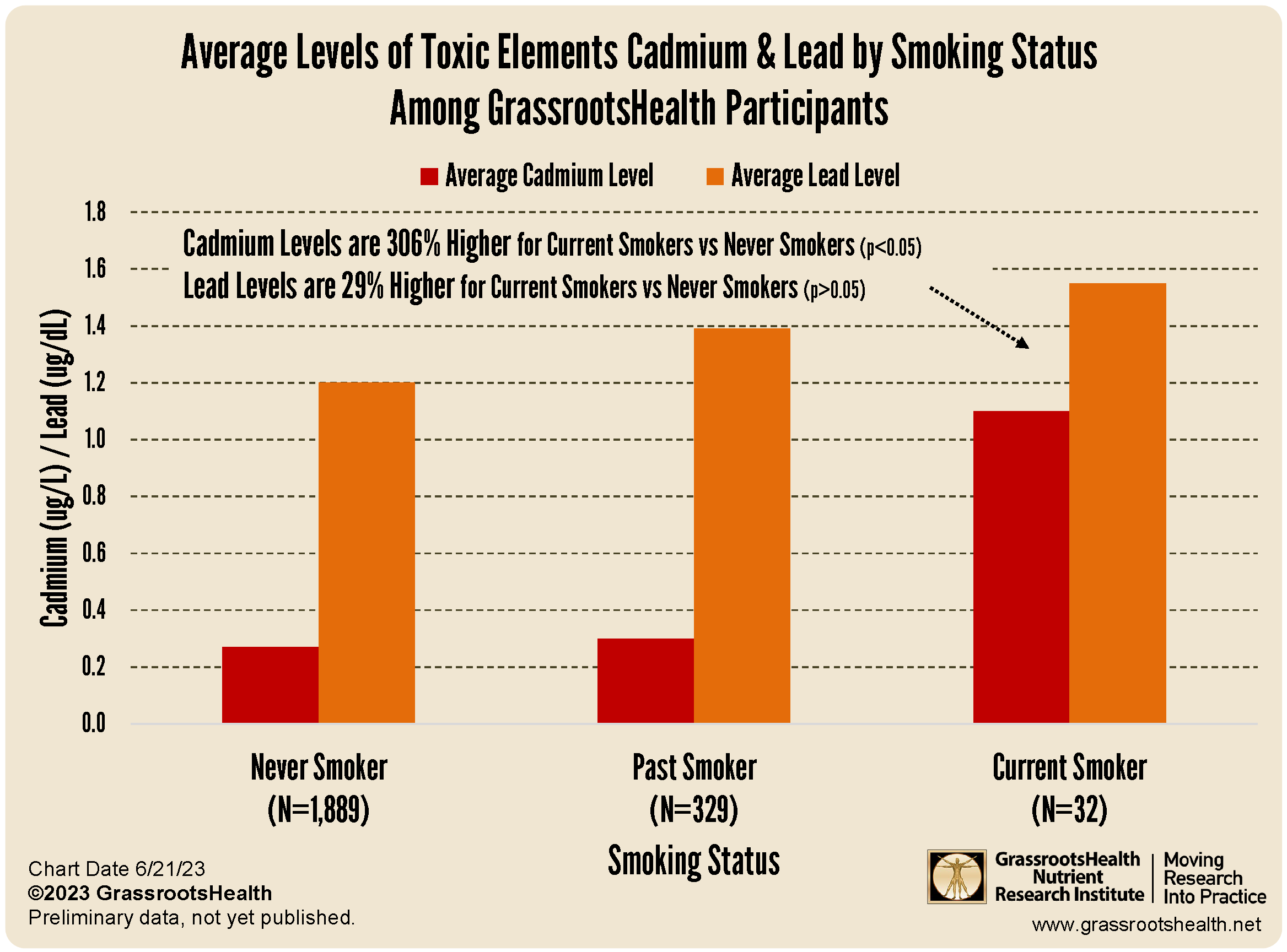Published on June 22, 2023
306% higher levels of cadmium and 29% higher lead levels found among GrassrootsHealth participants who are current smokers compared to those who have never smoked
Key Points
- There are over 7000 compounds found in cigarettes – two of which are toxic elements lead and cadmium, and both are associated with increased risk of many diseases
- GrassrootsHealth participants with elements results were grouped as “Never Smokers,” “Past Smokers,” and “Current Smokers” based on answers to the smoking section of the GrassrootsHealth questionnaire; levels of cadmium and lead were then compared between the groups. Only current smokers had cadmium levels above the lab reference range, which were also well above the CDC’s recommended limit.
- Studies have shown that low levels of zinc in the body may increase the risk of diseases resulting from cadmium toxicity, due to the antagonistic relationship between zinc and cadmium
 As part of Love Your Lungs Week, GrassrootsHealth decided to focus on a main contributor to lung disease – cigarette smoking. Smoking is a leading cause of preventable respiratory diseases as well as many other diseases and premature death. More than 7 million deaths each year can be attributed to cigarette smoking, according to a 2017 report by the World Health Organization. The detrimental health effects of smoking go well beyond respiratory health. In fact, smoking is linked to most fatal diseases, including cancer, chronic obstructive pulmonary disease (COPD), diabetes, stroke, and cardiovascular disease.
As part of Love Your Lungs Week, GrassrootsHealth decided to focus on a main contributor to lung disease – cigarette smoking. Smoking is a leading cause of preventable respiratory diseases as well as many other diseases and premature death. More than 7 million deaths each year can be attributed to cigarette smoking, according to a 2017 report by the World Health Organization. The detrimental health effects of smoking go well beyond respiratory health. In fact, smoking is linked to most fatal diseases, including cancer, chronic obstructive pulmonary disease (COPD), diabetes, stroke, and cardiovascular disease.
While those who quit smoking are still at higher risk of several of these diseases, the risk is much lower compared to those who continue to smoke. People exposed to passive cigarette smoke are also at higher risk of disease, including chronic respiratory diseases and infections, cancers including brain, sinus, breast, and leukemia, and cardiovascular diseases.
Cadmium and Lead – Two Toxic Heavy Metals Found in Cigarettes that Contribute to Their Negative Health Effects
There are over 7000 compounds found in cigarettes – two of which are toxic elements lead and cadmium. Cadmium, which is classified as a group 1 human carcinogen, is a soft, silver-white metal found in the earth’s crust. Individuals who work in specific industries, such as battery manufacturing and waste management, and smokers tend to have higher exposure to cadmium.
Long-term, lower level exposure results in cadmium accumulation in the kidneys and thyroid gland, and can contribute to thyroid issues, kidney disease, infertility, uterine fibroids, and other reproductive tract diseases if the build-up is high enough. Cadmium has also been found to cause cancer and to affect the body’s cardiovascular, neurological, gastrointestinal, and respiratory systems.
Lead is a metal from the earth’s crust that has been used in numerous products such as paint, pipes, gasoline, and batteries. With the discontinuation of lead-based paint and leaded gasoline in most countries, exposure to the general public has significantly declined.
Over time, low-level lead exposure can affect the body’s cardiovascular, reproductive, and renal systems and reduce vitamin D synthesis. Lead is particularly harmful to children because they absorb more lead than adults and their bodies are more vulnerable to its effects. In children, even low levels of lead in the blood can cause anemia, loss of hearing, lower IQ, hyperactivity, and behavior and learning problems.
GrassrootsHealth Data Shows Highest Levels of Lead and Cadmium Among Current Smokers
A recent analysis of data from the GrassrootsHealth cohort found that 1,550 participants have now had their levels of cadmium and lead measured as part of the Elements Panel (which tests essential elements magnesium, zinc, selenium and copper, and toxic elements lead, cadmium and mercury).
GrassrootsHealth wanted to see how levels of cadmium and lead differed among participants according to their smoking status. Participants with elements results were grouped based on answers to the smoking section of the GrassrootsHealth questionnaire. Participants who indicated they had never smoked 100 or more cigarettes were put in the “Never Smoker” group (N=1,889), those who said they had smoked 100 or more cigarettes, but did not currently smoke, were labeled as “Past Smokers” (N=329), and those who said they had smoked 100 or more cigarettes and still smoke were labeled “Current Smokers” (N=32).
The chart below illustrates the increasing average level of both lead and cadmium when going from “Never Smokers” to “Past Smokers” to “Current Smokers.” According to our analysis, cadmium levels were 306% higher for current smokers compared to never smokers (p<0.05), and lead levels were 29% higher for current smokers compared to never smokers (p>0.05).
Overall, average cadmium levels went from 0.27 μg/L for Never Smokers, 0.30 μg/L for Past Smokers, and 1.10 μg/L for Current Smokers with a significant trend. Average lead levels were 1.2 μg/dL for Never Smokers, 1.39 μg/dL for Past Smokers, and 1.55 μg/dL for Current Smokers. This trend was not significant.
According to the Centers for Disease Control (CDC), “The 95% confidence limit for blood cadmium levels in the United States for healthy nonexposed, nonsmokers is 0.4 micrograms per liter (µg/L).” Since both cadmium and lead are toxic metals that are harmful to our health, the optimal level of each of these is zero. Lab reference ranges for these elements, however, are below 1.04 μg/L for cadmium and below 2.23 μg/dL for lead.
Only current smokers had cadmium levels above the lab reference range, which were also well above the CDC’s recommended limit.
Zinc May Help Protect Against the Negative Effects of Cadmium
Studies have shown that low levels of zinc in the body may increase the risk of diseases resulting from cadmium toxicity, due to the antagonistic relationship between zinc and cadmium. According to Richter et al., “Cadmium antagonizes or inhibits some of the necessary biochemical functions of zinc and supplemented zinc inhibits or reverses some toxicological effects of cadmium. Consequently, the cadmium/zinc ratio may be more informative of health status than the concentrations of either metal alone.”
Make sure you are not being over exposed to the toxic elements cadmium and lead, and that you are getting enough zinc! Measure your levels of each, along with magnesium, selenium, copper, and mercury, by adding the Elements Panel to your next GrassrootsHealth home test kit.
Add the Elements Panel to Your Home Test Kit Here
Are You Getting Enough Vitamin D, Zinc, and Other Important Nutrients?
The only way to know is to test your levels! Testing versus blind supplementation is essential to know for sure if what you are taking is the right amount for you. Once you test your vitamin D (and other levels) to know where you are NOW, you can account for any upcoming changes in lifestyle over the coming months and adjust your intake to reach (or maintain) your targets.
- Vitamin D
- Magnesium PLUS Elements
- Omega-3 Fatty Acids
- hsCRP
- HbA1c
- TSH
- Type 1 Diabetes Autoantibodies
Did you know that each of the above can be measured at home using a simple blood spot test? As part of our ongoing research project, you can order your home blood spot test kit to get your levels, followed by education and steps to take to help you reach your optimal target levels. Start by enrolling and ordering your kit to measure each of the above important markers, and make sure you are getting enough of each to support better mood and wellbeing!
Create your custom home test kit today. Take steps to improve the status of each of these measurements to benefit your overall health. With measurement you can then determine how much is needed and steps to achieve your goals. You can also track your own intakes, symptoms and results to see what works best for YOU.
Enroll in D*action and Test Your Levels Today!







